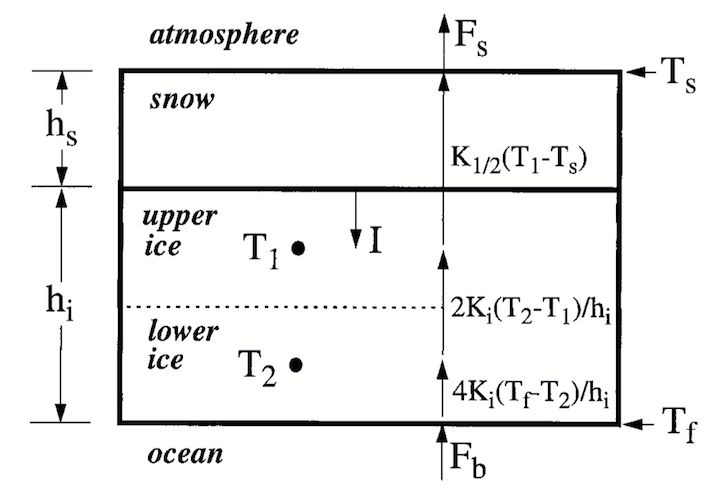This is three-layer thermodynomics sea-ice model based on Winton (2000) [195]. More...
Functions/Subroutines | |
| subroutine | sfc_sice::sfc_sice_run (im, kice, sbc, hvap, tgice, cp, eps, epsm1, rvrdm1, grav, t0c, rd, ps, t1, q1, delt, sfcemis, dlwflx, sfcnsw, sfcdsw, srflag, cm, ch, prsl1, prslki, prsik1, prslk1, wind, flag_iter, use_lake_model, lprnt, ipr, thsfc_loc, hice, fice, tice, weasd, tsfc_wat, tprcp, tiice, ep, snwdph, qss_i, qss_w, snowmt, gflux, cmm, chh, evapi, evapw, hflxi, hflxw, islmsk, errmsg, errflg |
| subroutine | ice3lay |
| This subroutine is the entity of three-layer sea ice vertical thermodynamics based on Winton(2000) [195] . More... | |
The model has four prognostic variables: the snow layer thickness \(h_s\), the ice layer thickness \(h_i\), the upper and lower ice layer temperatures located at the midpoints of the layers \(h_i/4\) and \(3h_i/4\) below the ice surface, respectively \(T_1\) and \(T_2\). The temperature of the bottom of the ice is fixed at \(T_f\), the freezing temperature of seawater. The temperature of the top of the ice or snow, \(T_s\), is determined from the surface energy balance. The model consists of a zero-heat-capacity snow layer overlying two equally thick sea ice layers (Figure 1). The upper ice layer has a variable heat capacity to represent brine pockets.

The ice model main program ice3lay() performs two functions: